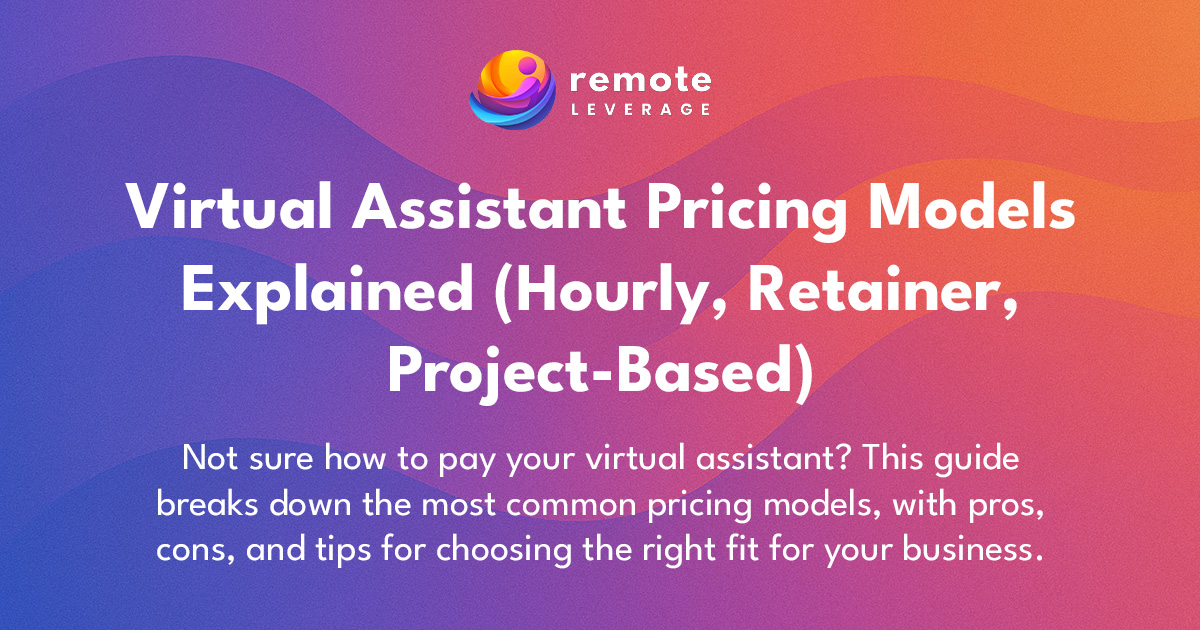
Hiring a virtual assistant can be one of the smartest moves you make for your business — but understanding how to pay them can be confusing.
There’s no single “industry standard” when it comes to virtual assistant pricing. Different assistants (and platforms) use different structures, depending on their experience, location, and the kind of support they offer.
In this guide, we’ll walk through the three most common pricing models:
You’ll learn how each works, what they cost, and when to use them.
A hybrid team blends:
This structure helps companies stay agile, responsive, and cost-effective — without sacrificing quality.
Choosing the right pricing model helps you:
It also helps your VA understand how to best deliver value — whether they’re supporting you 5 hours a week or managing a high-volume project.
How it works:
You pay the assistant based on the number of hours worked, tracked weekly or monthly. Tools like Toggl or Harvest are often used to log time.
Common hourly rates:
Best for:
Pros:
Cons:
How it works:
You pay a fixed monthly fee for a set number of hours or tasks. Most retainers start at 20 hours per month and increase based on needs.
Common rates:
Best for:
Pros:
Cons:
Note: At Remote Leverage, we don’t charge monthly fees. You pay a one-time match fee and then pay your VA directly. That keeps things transparent, fair, and cost-effective for both sides.
How it works:
You agree on a flat rate for a specific project or deliverable. This could be a website audit, a CRM cleanup, a database build, or content scheduling for the month.
Common price ranges:
Best for:
Pros:
Cons:
Here’s a quick comparison:
| Pricing Model | Best For | Predictable Cost | Scalable | Relationship Type |
| Hourly | Flexible tasks, testing the waters | Low | High | Short-term or mid-term |
| Retainer | Consistent ongoing support | Yes | Yes | Long-term, team-based |
| Project-Based | One-off tasks with clear outcomes | Yes | No | Task-based or specialized |
Many VA agencies charge clients $3,000+ per month while paying their assistants as little as $5/hour. That means you’re often paying for agency overhead — not talent.
At Remote Leverage, we do things differently:
This means more of your money goes toward actual support — and your assistant is paid fairly.
Q: How do I know if an hourly VA is productive?
Most assistants track their time using tools like Toggl or Clockify. You can also assign tasks with estimated times and review output each week.
Q: Is a retainer more expensive in the long run?
Not necessarily. If you’re using your VA consistently, a retainer often gives you better value per hour than pay-as-you-go support.
Q: Can I switch from hourly to retainer later?
Yes. Many clients start hourly to test the relationship, then switch to a monthly agreement once they’re confident in the VA’s performance.
Q: What if I don’t use all my retainer hours?
Some assistants roll hours over. Others don’t. This is something to clarify upfront so there are no surprises later on.
Q: How does Remote Leverage structure pricing?
We don’t charge recurring fees. You pay a one-time fee for the VA match, and then you pay your assistant directly. This gives you full control and saves money every month.
Virtual assistant pricing isn’t one-size-fits-all. The right structure depends on how you work, how much support you need, and how flexible you want the relationship to be.
Whether you’re delegating 5 hours of admin work or building a long-term hybrid team, knowing how VAs charge helps you plan better and hire smarter.
Remote Leverage helps businesses hire highly skilled, college-educated virtual assistants from Latin America. No ongoing fees. No hidden costs.
✅ Hire from Latin America
✅ Fluent in English and experienced
✅ Skilled in CRMs, email, project management, and more
✅ One-time match fee — then pay your VA directly
✅ Plug-and-play support that fits your budget
👉 Book your free call and get matched today
Grow your business without growing your overhead.